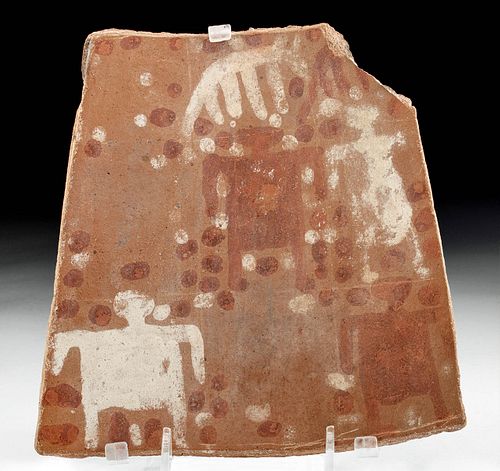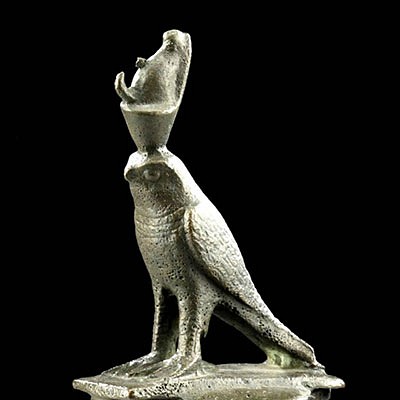Inca Chucu Polychrome Plaque w/ Human & Alpaca Pattern
Lot 111
About Seller
Artemis Fine Arts
686 S Taylor Ave, Ste 106
Louisville, CO 80027
United States
Selling antiquities, ancient and ethnographic art online since 1993, Artemis Gallery specializes in Classical Antiquities (Egyptian, Greek, Roman, Near Eastern), Asian, Pre-Columbian, African / Tribal / Oceanographic art. Our extensive inventory includes pottery, stone, metal, wood, glass and textil...Read more
Estimate:
$700 - $1,000
Absentee vs Live bid
Two ways to bid:
- Leave a max absentee bid and the platform will bid on your behalf up to your maximum bid during the live auction.
- Bid live during the auction and your bids will be submitted real-time to the auctioneer.
Bid Increments
| Price | Bid Increment |
|---|---|
| $0 | $25 |
| $300 | $50 |
| $1,000 | $100 |
| $2,000 | $250 |
| $5,000 | $500 |
| $10,000 | $1,000 |
| $20,000 | $2,500 |
| $50,000 | $5,000 |
| $100,000 | $10,000 |
| $200,000 | $20,000 |
About Auction
By Artemis Fine Arts
Feb 11, 2021
Set Reminder
2021-02-11 12:00:00
2021-02-11 12:00:00
America/New_York
Bidsquare
Bidsquare : Animals in Art | Antiquity to Present Day
https://www.bidsquare.com/auctions/artemis-gallery/animals-in-art-antiquity-to-present-day-6391
From beloved pets to dedicated servants and vital livestock to symbolic imagery from many religions, animals frequently show up in the art of all cultures, ancient times to the present. Artemis Fine Arts info@artemisfinearts.com
From beloved pets to dedicated servants and vital livestock to symbolic imagery from many religions, animals frequently show up in the art of all cultures, ancient times to the present. Artemis Fine Arts info@artemisfinearts.com
- Lot Description
Pre-Columbian, southern Peru, Inca hinterlands (Chucu), ca. 1000 to 1500 CE. A rectangular pottery plaque of a slightly concave form from a larger ceramic vessel hand painted with vibrant figures of stylized anthropomorphic and zoomorphic forms. The plaque has three by three rows and columns of minimalist human figures facing forward with four legged camelids, perhaps alpaca, in profile. All of these charming figures are painted in shades of creamy beige and burnt sienna upon a russet-hued ground. Pieces of micah applied to the concave surface cause this beautiful piece to glisten and sparkle in the sunlight. Plaques like this example were placed as offerings to Pacha Mama and Pacha Papa (Mother and Father Earth) to protect the health of the livestock and the human inhabitants of the clan. Custom suspension hook attachment included, however Lucite stand is not. Size: 7" W x 7.125" H (17.8 cm x 18.1 cm)
These plaques were made by smashing large vessels and painting the fragments. They have been discovered in several different contexts: beneath wall foundations, in graves, with animal sacrifices, and cached in prominent places in the landscape such as springs, rock hollows, and atop hills. They are often discovered in pairs, with the painted surfaces placed so that they are facing each other, sometimes wrapped in leaves or even gold sheet. Although the tablet tradition began centuries before, the time period that this one comes from represents the height of the artform, and corresponds to an intensification of agriculture, the rise of interregional trade networks, and the ascendancy of certain important confederations of clans. Into this potent mix, the Inca expanded into the region, and the tablet tradition abruptly ended. It seems likely that the Inca, who colonized regions in part by sponsoring local ritual activities, outlawed the creation of religious tablets like this, because they saw them as a threat to their trade in sacrificial alpacas, corn beer, and cloth.
Provenance: ex-private Hawaii, USA collection; ex-private Hillberg collection, California, USA before 1990
All items legal to buy/sell under U.S. Statute covering cultural patrimony Code 2600, CHAPTER 14, and are guaranteed to be as described or your money back.
A Certificate of Authenticity will accompany all winning bids.
We ship worldwide and handle all shipping in-house for your convenience.
#150640Fragment of a larger vessel. Age commensurate surface scratches and abrasions to peripheries. Otherwise intact with impressive pigments!Condition
- Shipping Info
-
All shipping is handled in-house for your convenience. Your invoice from Artemis Gallery will include shipping calculation instructions. If in doubt, please inquire BEFORE bidding for estimated shipping costs for individual items.
-
- Buyer's Premium



 EUR
EUR CAD
CAD AUD
AUD GBP
GBP MXN
MXN HKD
HKD CNY
CNY MYR
MYR SEK
SEK SGD
SGD CHF
CHF THB
THB














